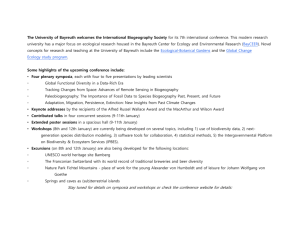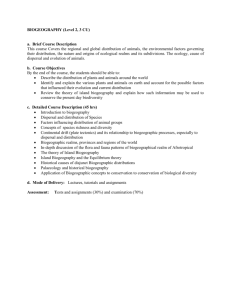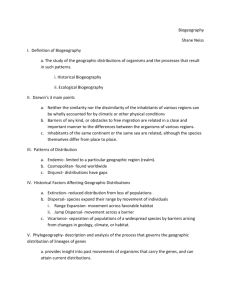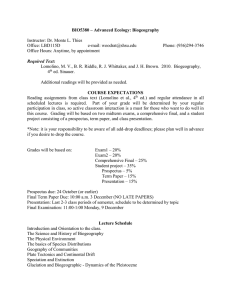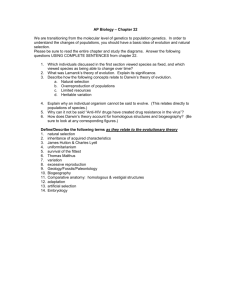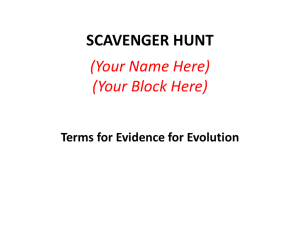Syllabus - Campus Email - California State University, Fresno
advertisement
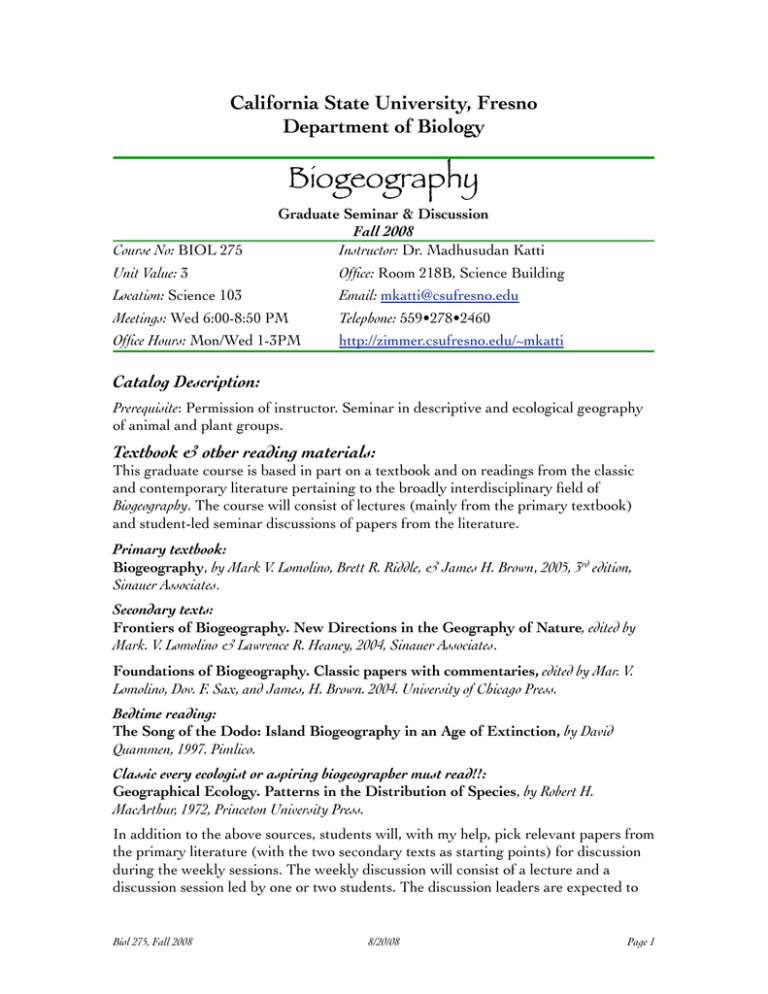
California State University, Fresno Department of Biology Biogeography Graduate Seminar & Discussion Fall 2008 Course No: BIOL 275 Instructor: Dr. Madhusudan Katti Unit Value: 3 Office: Room 218B, Science Building Location: Science 103 Email: mkatti@csufresno.edu Meetings: Wed 6:00-8:50 PM Telephone: 559•278•2460 Office Hours: Mon/Wed 1-3PM http://zimmer.csufresno.edu/~mkatti Catalog Description: Prerequisite: Permission of instructor. Seminar in descriptive and ecological geography of animal and plant groups. Textbook & other reading materials: This graduate course is based in part on a textbook and on readings from the classic and contemporary literature pertaining to the broadly interdisciplinary field of Biogeography. The course will consist of lectures (mainly from the primary textbook) and student-led seminar discussions of papers from the literature. Primary textbook: Biogeography, by Mark V. Lomolino, Brett R. Riddle, & James H. Brown, 2005, 3rd edition, Sinauer Associates. Secondary texts: Frontiers of Biogeography. New Directions in the Geography of Nature, edited by Mark. V. Lomolino & Lawrence R. Heaney, 2004, Sinauer Associates. Foundations of Biogeography. Classic papers with commentaries, edited by Mar. V. Lomolino, Dov. F. Sax, and James, H. Brown. 2004. University of Chicago Press. Bedtime reading: The Song of the Dodo: Island Biogeography in an Age of Extinction, by David Quammen, 1997. Pimlico. Classic every ecologist or aspiring biogeographer must read!!: Geographical Ecology. Patterns in the Distribution of Species, by Robert H. MacArthur, 1972, Princeton University Press. In addition to the above sources, students will, with my help, pick relevant papers from the primary literature (with the two secondary texts as starting points) for discussion during the weekly sessions. The weekly discussion will consist of a lecture and a discussion session led by one or two students. The discussion leaders are expected to Biol 275, Fall 2008 8/20/08 Page 1 dig a little deeper into the background literature supporting the focal paper. All students are expected to carefully read at least the main papers discussed each week, and encouraged to read additional background papers as are made available. This course is web-enabled so readings and additional material will be available on Blackboard (http://blackboard.csufresno.edu/) - make sure to use that site frequently. As the above list indicates, I expect you to read a lot this semester, and think you will enjoy most of the literature sources, especially the MacArthur and Quammen books. The subject is also multidisciplinary, so you will have the opportunity to step outside your background training to some extent, as well as apply your own special expertise to some questions about how, why, where, and when organisms are distributed. Assessment This being a seminar course at the graduate level, there will be no exams. Instead, 60% of your grade will depend largely upon your participation in the class discussions. Each student is expected to lead discussion of papers at least once during the semester. You will also be asked to submit (for another 15% of total grade) at least one essay summarizing a class discussion (led by someone other than you) as a post to be published on the blog: http://evolvefresno.blogspot.com/. For the remaining 25% of your grade, you are required to either collaborate on a group project leading to a paper, or write a review article on a relevant topic, chosen in consultation with me, and drawing upon appropriate literature. Finally, if you miss two or more class meetings without strong justification, your grade will be reduced by at least one letter grade. Subject to Change This syllabus and schedule are subject to change in the event of extenuating circumstances. If you are absent from class, it is your responsibility to check on announcements made while you were absent. University & Course Policies: I fully support the university’s policies, including, but not limited to, the following: Students with Disabilities: Upon identifying themselves to the instructor and the university, students with disabilities will receive reasonable accommodation for learning and evaluation. For more information, contact Services to Students with Disabilities in the University Center Room 5 (278-2811). Honor Code: “Members of the CSU Fresno academic community adhere to principles of academic integrity and mutual respect while engaged in university work and related activities.” You should: a) understand or seek clarification about expectations for academic integrity in this course (including no cheating, plagiarism and inappropriate collaboration) b) neither give nor receive unauthorized aid on examinations or other course work that is used by the instructor as the basis of grading. c) take responsibility to monitor academic dishonesty in any form and to report it to the instructor or other appropriate official for action. Biol 275, Fall 2008 8/20/08 Page 2 I may, during the course of this class, require you to sign the following statement about your work on exams and assignments: “I have done my own work and have neither given nor received unauthorized assistance on this work.” Cheating and Plagiarism: "Cheating is the actual or attempted practice of fraudulent or deceptive acts for the purpose of improving one's grade or obtaining course credit; such acts also include assisting another student to do so. Typically, such acts occur in relation to examinations. However, it is the intent of this definition that the term 'cheating' not be limited to examination situations only, but that it include any and all actions by a student that are intended to gain an unearned academic advantage by fraudulent or deceptive means. Plagiarism is a specific form of cheating which consists of the misuse of the published and/or unpublished works of others by misrepresenting the material (i.e., their intellectual property) so used as one's own work." Penalties for cheating and plagiarism range from a 0 or F on a particular assignment, through an F for the course, to expulsion from the university. For more information on the University's policy regarding cheating and plagiarism, refer to the Class Schedule (Legal Notices on Cheating and Plagiarism) or the University Catalog (Policies and Regulations). Computers: "At California State University, Fresno, computers and communications links to remote resources are recognized as being integral to the education and research experience. Every student is required to have his/her own computer or have other personal access to a workstation (including a modem and a printer) with all the recommended software. The minimum and recommended standards for the workstations and software, which may vary by academic major, are updated periodically and are available from Information Technology Services or the University Bookstore. In the curriculum and class assignments, students are presumed to have 24hour access to a computer workstation and the necessary communication links to the University's information resources." Disruptive Classroom Behavior: "The classroom is a special environment in which students and faculty come together to promote learning and growth. It is essential to this learning environment that respect for the rights of others seeking to learn, respect for the professionalism of the instructor, and the general goals of academic freedom are maintained. ... Differences of viewpoint or concerns should be expressed in terms which are supportive of the learning process, creating an environment in which students and faculty may learn to reason with clarity and compassion, to share of themselves without losing their identities, and to develop an understanding of the community in which they live. ... Student conduct which disrupts the learning process shall not be tolerated and may lead to disciplinary action and/or removal from class." Copyright policy: Copyright laws and fair use policies protect the rights of those who have produced the material. The copy in this course has been provided for private study, scholarship, or research. Other uses may require permission from the copyright holder. The user of this work is responsible for adhering to copyright law of the U.S. (Title 17, U.S. Code). To help you familiarize yourself with copyright and fair use policies, the University encourages you to visit its copyright web page: Biol 275, Fall 2008 8/20/08 Page 3 http://www.csufresno.edu/library/libraryinformation/campus/copyright/ copyrtpolicyfull.pdf For copyright Questions & Answers: http://www.csufresno.edu/library/ libraryinformation/campus/copyright/faqcopyright.pdf Digital Campus course web sites contain material protected by copyrights held by the instructor, other individuals or institutions. Such material is used for educational purposes in accord with copyright law and/or with permission given by the owners of the original material. You may download one copy of the materials on any single computer for non-commercial, personal, or educational purposes only, provided that you (1) do not modify it, (2) use it only for the duration of this course, and (3) include both this notice and any copyright notice originally included with the material. Beyond this use, no material from the course web site may be copied, reproduced, republished, uploaded, posted, transmitted, or distributed in any way without the permission of the original copyright holder. The instructor assumes no responsibility for individuals who improperly use copyrighted material placed on the web site. Course Goals and Primary Learning Outcomes The course aims to teach students the basic principles of Biogeography, starting with a historical context and bringing them up to date with the latest developments at the frontiers of the discipline. Students will be able to draw upon multidisciplinary tools from ecology, evolutionary biology, geography and geology, to analyze and understand the where, when, how, and why, of the occurrence of organisms on earth. Students will also be able to ask interesting questions about species distributions, generate testable hypotheses, find and draw upon the relevant peer-reviewed literature, and synthesize existing knowledge to help address such hypotheses. Finally, students are encouraged to incorporate these approaches into their own research projects / theses. Biol 275, Fall 2008 8/20/08 Page 4 Course schedule: Discussion topics and dates are subject to change with notice according to circumstance, necessity, or other compelling reason (like me getting behind). The discussion papers will generally align with the lecture topic for each week. Papers for discussion must be chosen and distributed by Monday of each week to provide sufficient time for everyone to read them. WEEK READING (primary textbook) WEEK 1: (27 Aug) Introduction, history and scope of Biogeography Chapters 1-2 WEEK 2: (3 Sep). The Geographic Template & Ecological Foundations Chapter 3-4 WEEK 3: (10 Sep). Distributions of Species & Communities Chapter 4-5 WEEK 4: (17 Sep). Fundamental Processes: Dispersal & Immigration Chapter 6 WEEK 5: (24 Sep). Fundamental Processes: Speciation & Extinction Chapter 7 WEEK 6: (1 Oct). Fundamental Processes: The Changing Earth Chapter 8 WEEK 7: (8 Oct). Fundamental Processes: Glaciation and Pleistocene Dynamics. WEEK 8: (15 Oct). Evolutionary History of Lineages: Geography of Diversification. WEEK 9: (22 Oct). Evolutionary History of Lineages: Reconstructing the History of Lineages WEEK 10: (29 Oct). Evolutionary History of Lineages: Reconstructing the History of Biotas Chapter 9 Chapter 10 Chapter 11 Chapter 12 WEEK 11: (5 Nov) Ecological Biogeography: Island Biogeography Chapters 13-14 WEEK 12: (12 Nov) Ecological Biogeography: Island Biogeography, Areography, Ecogeographic Rules, & Diversity Gradients Chapters 14-15 WEEK 13: (19 Nov). Biodiversity and the Geography of Extinctions Chapter 16 WEEK 14: (26 Nov). Culinary Biogeography of Turkeys?! WEEK 15: (3 Dec). Conservation Biogeography and Human Biogeography. Chapters 17-18 WEEK 16: (10 Dec) End of semester thoughts! Potluck, perhaps! Everything FINALS WEEK - Project / Review Article Due. Biol 275, Fall 2008 8/20/08 Page 5
